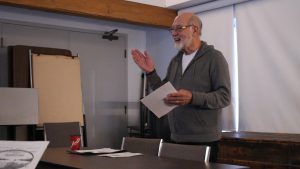Appreciating Windsor’s border city culture
By Dawn Gray

Local historian Larry Kulisek spoke at the Duff Baby house on April 5, 2018. Photo by Dawn Gray.
Windsor and Detroit are two international cities connected by much more than a tunnel and a bridge.
The connection of these cities goes way back. They are linked through history, wars, prohibition and the rise of the auto industry after the U.S.-Canadian Auto Pact in the 1960s.
Larry Kulisek, a local historian knows all about these connections. He was invited to the Duff Baby house on Thursday to speak for the Windsor Museum Volunteer Group about his research.
“Generally, in the 19th century workers used both sides of the border for economic opportunity and the border was open in either direction,” said Kulisek. “The War of 1812 gave finality to the border, which has not been seriously questioned again.”
Kulisek said the two cities have a very intriguing history that has become a part of our culture as a border city. Over the years, business, community, traditions, trade and liquor have all crossed this border.
“When Hiram Walker and Henry Ford moved to this side of the border, the connection was reinforced.”
The Windsor-Detroit area is a critical link of the Canada-U.S. border. Traffic crossing the border is anticipated to grow from 19,000 vehicles a day to more than 26,000 by the year 2020. It is the busiest border crossing in the country, but Kulisek said it is not unique.
“They all have similar stories of interaction such as smuggling and entrepreneurial advantages or opportunities because of the difference in federal, provincial and state laws,” said Kulisek.
The two areas have a combined population of over 6 million people. It is North America’s largest cross-border, urban area. If the two cities were recognized as a single metropolitan, it would be the eighth most populated urban region in North America.


